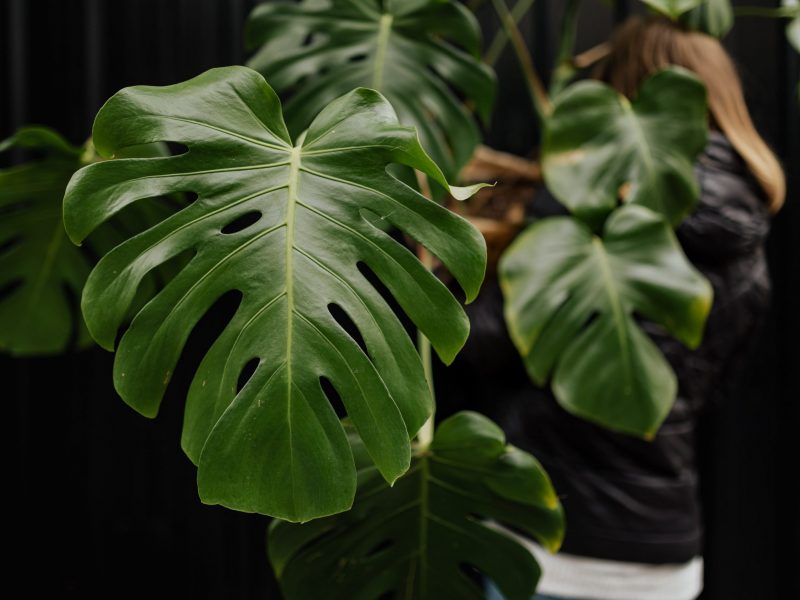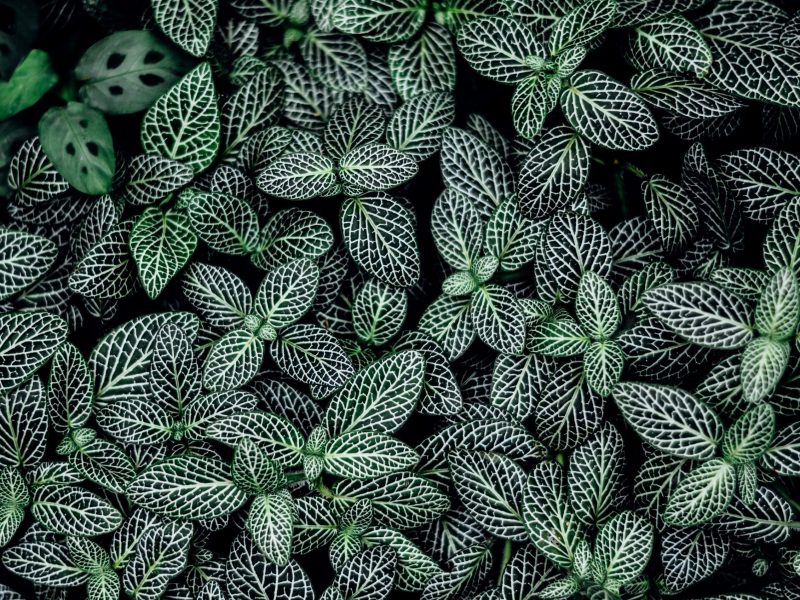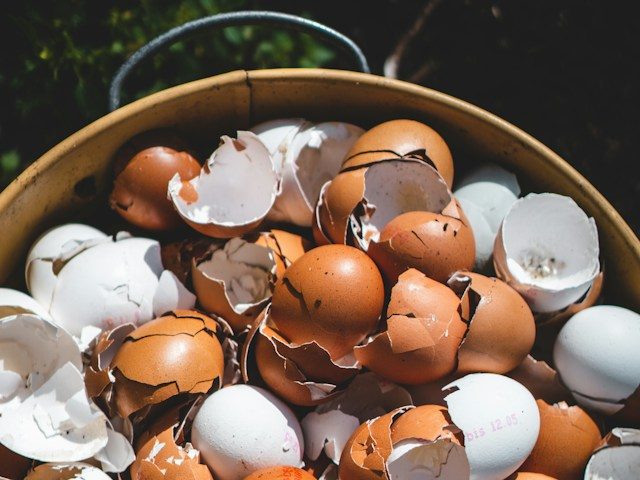
Why plants might love your bathroom…
If you’re wanting to bring a bit of greenery to your bathroom, then you’ll be pleased to know that it can be heaven for tropical plants. This is because showering means there’s usually a naturally higher humidity level in your bathroom compared to the rest of your home. It becomes a little more like the tropical rainforests that a lot of plants are native to.
One thing you just have to watch out for is how much natural sunlight your plants will get. Often bathrooms have smaller windows which can make finding the perfect plant a little thicker. Oh and if your bathroom doesn’t have a window at all, then unfortunately, you will most likely have to settle on fake plants.

African Mask Plant
Alocasia amazonica
If there is one plant that has risen up the popularity ranks recently, it’s the African Mask Plant! You can now buy these at basically every plant shop, market and superstore globally as they are definitely the most popular of the Alocasia family. And we totally understand why they have become so popular, their intense glossy shield-like leaves are adorned with strong white veins which really make them something special.
They aren’t a great plant for beginners, however, as they do require decent light levels, as well as warm temperatures and a consistent high humidity level. Misting this plant is really crucial or it’ll start to develop some issues. However, by placing them in your bathroom you can often avoid the need for misting, as the humidity from your showers will do all the hard work for you.
If in the right environment, your African Mask Plant can grow well above 1 metre but this will take many years as they don’t produce that many new leaves each year. This is why it’s crucial you take good care of the leaves your plant does have by regularly dusting and inspecting for issues.
Find out more in our African Mask Plant care guide.

Air Plant
Tillandsia
There are hundreds of Air Plant varieties for you to fall in love with, all with relatively similar care requirements. If you haven’t already guessed from the name, Air Plants are pretty different to most other houseplant types as they don’t grow in soil. Instead, all they need is regular misting and the occasional bath to survive!
Native to areas across Central and South America, Air Plants need warm temperatures and high humidity levels to really thrive which makes them great plants for your bathroom. They also thrive in terrariums if that’s something you’re into. But don’t think terrariums is the only way to grow Air Plants, because with a little bit of care and attention to their environment, you can grow them in most homes and rooms with no problems!
Find out more in our Air Plant care guide.

Swiss Cheese Plant
Monstera deliciosa
Native to the rainforests of Central America, the Monstera Deliciosa has very quickly become the most fashionable and photographed houseplant ever. And it’s not difficult to understand why… If their large dark green glossy heart-shaped leaves weren’t enough, their unique splits surely will be! It’s really something to bring the wow factor to your bathroom which can often be quite an unloved room.
You might be surprised to learn that the Monstera isn’t actually a fussy plant and is pretty easy to take care of. Bright but indirect light, moderate amounts of water and regularly misting are really the main things to remember (if placed in your bathroom this can usually remove the need for misting).
You’ll find that a lot of more mature Monstera plants are sold with a moss pole as they are climbing plants. In the rainforest, the ariel roots that pop out from the stems will attach themselves to other plants as the plant matures. So a moss pole is a good substitution to help your plant grow and mature.
Find out more in our Swiss Cheese Plant care guide.

Watermelon Peperomia
Peperomia argyreia
There aren’t really many leaves that are more beautiful and striking than those of the Watermelon Peperomia. It’s not difficult to know where they got their name from, as their silvery stripes steal the hearts of plant parents everywhere.
They are quite a delicate plant though, as their large heavy leaves are held up by relatively weak stems so be prepared to lose a few leaves here and there. Another thing to be prepared for when owning this plant is all of your friends wanting a cutting, but luckily this plant is super easy to propagate so no problems there!
Native to South Africa, the Watermelon Peperomia prefers mid-light levels, as they are used to the dappled conditions of the jungle floor. Oh, and as they are a semi-succulent, it’s important you don’t water this one too much or the stems can give up and the whole plant will droop and wilt. Keeping them in the bathroom is great as they’ll get a nice constant high humidity level, as well as enough moisture to mean you don’t have to remember to water it that often either. It’s the perfect spot!
Find out more in our Watermelon Peperomia care guide.

Boston Fern
Nephrolepis exaltata
If you want to bring some jungle into your bathroom, then the lush Boston Fern is a great way to go! However, looking after them isn’t always easy as they can be a little fussy when grown indoors. There are two main things that your Boston Fern needs; bright sunshine and high humidity. By placing your Boston Fern in the bathroom, it removes the need to mist the leaves on a daily basis which makes caring for it a lot less hassle.
The one downside we find to owning Boston Ferns is that they do shed a lot of leaves so you’ll find yourself tidying up after it quite a lot. This can get a little annoying if placed right next to the sink or bath as you don’t want the leaves blocking the drains. But with the right care, they’ll reward you with luscious green wilderness.
Another great thing about Boston Ferns is they are pretty cheap and you shouldn’t run into too much trouble finding them in plant shops around the world.
Find out more in our Boston Fern care guide.

Peace Lily
Spathiphyllum wallisii
There’s a reason that Peace Lilies are so popular, and it’s not just because of their incredible white flowers. They are super low maintenance plants that can adapt and thrive in most homes. They can tolerate all light levels which is super rare for houseplants and means it’s great for bathrooms with plenty of sunshine, as well as those which might be a little dark.
Our favourite thing about the Peace Lily is that it really helps us plant parents out by drooping its leaves when it really needs water. This can help you spot underwatering before it’s really a problem. Within minutes of watering, the leaves will perk up – it’s pretty cool! And if we haven’t sold you on the Peace Lily yet, then you should probably know that they are also one of the best plants at purifying the air and removing chemicals from your home!
Find out more in our Peace Lily care guide.

Nerve Plant
Fittonia albivenis
With delicate leaves, Nerve Plants are low-growing spreader plants that aren’t always the easiest to care for. The most popular and common variety is silver and green-veined, though you’ll also often spot varieties with white, pink or red veins and leaves too!
They have quite specific care requirements though so we don’t tend to recommend them to beginner plant parents as they are quite fussy about balancing the level of light, water, humidity and temperature. We usually recommend daily misting to prevent them from drying out, but by placing them in the bathroom, you can avoid needing to do this at all!. And if you manage to get the care routine nailed down, then they are totally worth the extra hassle!
Find out more in our Nerve Plant care guide.

Peacock Plant
Calathea makoyana
The Calathea makoyana is known and loved for the bold and unique markings on the leaves, as well as their red undersides, a classic trademark of many Calathea plants. Peacock plants don’t grow very tall so are perfect for smaller bathrooms and spaces.
When it comes to care, it’s important to note that the Peacock Plant can be a little temperamental sometimes, so we don’t always recommend this one to plant beginners. You must keep them away from direct light and never let them fully dry out for long periods of time. They also need quite warm temperatures to really thrive, so drafts and AC vents are a no-go for Peacock Plants. By keeping them in the bathroom, you won’t have to mist this one at all, and the extra humidity can also help to keep the leaves clean which is important with the Peacock Plant.
Peacock Plants can grow very small white flowers sometimes, but don’t think you aren’t caring for your plant properly if it doesn’t bloom. Flowers are quite rare and unpredictable, but a nice surprise when it does happen!
Find out more in our Peacock Plant care guide.

Philodendron Birkin
Philodendron Birkin
This used to be an extremely rare and unknown plant but over the past few years, it’s definitely gained a place in the houseplant walk of fame! Unlike a lot of its Philodendron relatives, the Birkin is a non-vining plant that stays pretty compact, making it great for the windowsill of your bathroom or generally smaller spaces.
Loved for their green and cream striped leaves, the Philodendron Birkin needs a humid environment to really thrive. This is because they are native to the rainforests of Brazil you’d usually need to mist the plant often, as otherwise, you’ll see brown leaves appear pretty quickly. But the humidity that comes with daily showering will really help this one thrive. With the right care and environment, the Birkin can be a pretty quick grower so it’s definitely worth a little bit of extra hassle.
Find out more in our Philodendron Birkin care guide.

Pinstripe Calathea
Calathea ornata
This is probably one of our favourite houseplants here at Fiddle and Thorn. Whilst they are a little fussier than a lot of other plants, their stunning pink striped leaves really make up for it. Their dark green glossy leaves can reach up to around 30cm when your plant starts to mature, making them perfect for that corner of the bathroom that you just don’t know what to do with.
Native to South America, these plants need high humidity or you’ll very quickly see dry leaf edges appear which is why they are a great fit for the bathroom. You also want to keep them away from intense light or the pink stripes will start to fade which is always devastating. Oh, and if you needed another reason to love the Pinstripe Calathea, they are safe for pets and humans so you don’t need to worry about having them around your home.
Find out more in our Pinstripe Calathea care guide.

Polka Dot Plant
Hypoestes phyllostachya
Polka Dot Plants come in all kinds of colours, from pink to green, white and red. Although they have super delicate leaves, they aren’t actually too difficult to care for so long as they don’t receive any direct light (this fades and burns the leaves) and don’t have to sit in any waterlogged soil.
One great thing about Polka Dot Plants is that they can very happily adapt to a range of light levels, so if you’re looking for something to fill that shady corner of the bathroom, you might have just found the perfect plant! They are relatively non-toxic too which means as long as your pet or child doesn’t consume a really large quantity of this plant, they’ll be absolutely fine.
If we had to sum up this plant in just one sentence it would be they are the perfect fit for someone who is looking for a little special something but doesn’t want all the faff that can come with a lot of other houseplants!
Find out more in our Polka Dot Plant care guide.

Rubber Plant
Ficus elastica
The name Rubber Plant comes from the latex in the leaves, which was once used to actually make rubber! They are a great plant to bring a little bit of that rainforest feel right into your home. And whilst they can reach about 30 metres in their native environment, when potted in your home they’ll be much smaller don’t worry!
Caring for your Rubber Plant doesn’t have to be difficult. Good light levels and not too much water are the basics to remember. As they are native to Southern Asia, they love humidity and will really struggle with dry air so putting them in the bathroom will help to prevent dry brown leaves.
Find out more in our Rubber Plant care guide.














